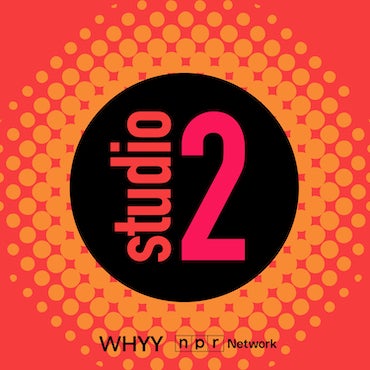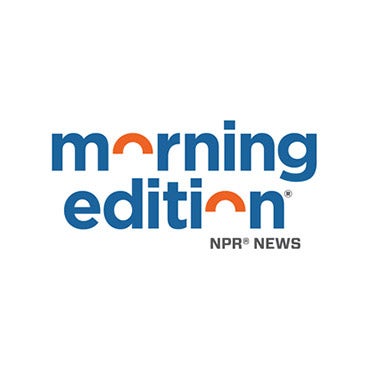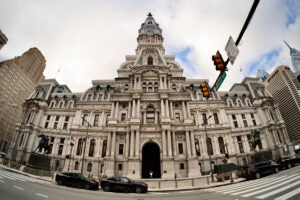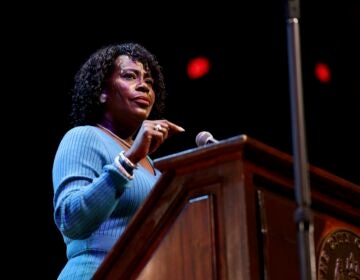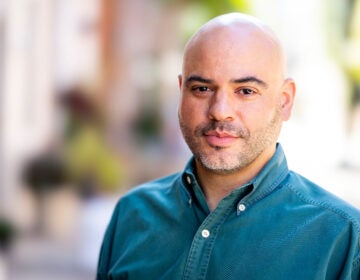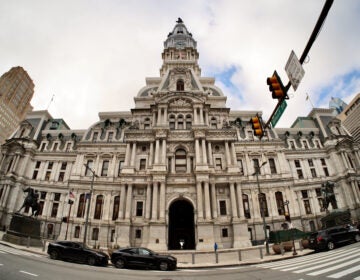Philly voters give Mayor Parker mixed reviews, would like to see her be more visible
Residents surveyed by The Lenfest Institute cited concerns over the mayor's "clean and green" initiative and handling of the opioid epidemic in Kensington.
Listen 1:00
Philadelphia Mayor Cherelle Parker delivered her second budget address on March 13, 2025. (Kimberly Paynter/WHYY)
From Philly and the Pa. suburbs to South Jersey and Delaware, what would you like WHYY News to cover? Let us know!
Civic pride is alive and well in Philadelphia, but so is rampant open drug use, aging school buildings and frustrations with government visibility.
That’s the central takeaway from a new qualitative study conducted by survey research firm SSRS for the Lenfest Institute for Journalism, which offers an in-depth view into how residents across the city perceive the early efforts of Mayor Cherelle Parker’s administration.
The project — part of Lenfest’s Every Voice, Every Vote — convened eight focus groups representing 67 Philadelphians from diverse backgrounds. The focus group, a follow-up to an earlier one conducted before the start of the Parker administration, asked participants to weigh in on the mayor’s initiatives on education, public safety, environmental quality and civic engagement.
“Every Voice, Every Vote is about not just getting people out to vote, but also hearing people’s voices about the issues that concern them most,” explained Jared Council, editorial project lead. “They told us what the top issues were a few years ago, and we wanted to dive a little deeper now to hear about how they feel about progress in those three areas, public safety, education and clean and green initiatives.”
The research reveals a public eager for progress but grappling with skepticism, logistical barriers and uneven experiences of policy implementation. Regardless of where they lived, residents shared many of the same concerns: school conditions, street cleanliness, crime and a lack of communication from city officials.
One of the study’s clearest messages was a desire for increased visibility from the mayor and her administration. Many participants remembered seeing Cherelle Parker ride SEPTA and walk in Kensington during her campaign, but they haven’t seen her in the neighborhoods since taking office.
The study also found that awareness of some city initiatives was high, but detailed understanding was often lacking. For example, residents had heard of pilot programs like year-round school and extended school days, but were unsure about how they were being implemented, or if they would continue.
Overcrowded classrooms
Education emerged as both a source of local pride and deep frustration. While participants praised dedicated teachers and new literacy programs, they were overwhelmingly concerned about underfunded schools, low teacher pay and decrepit facilities.
“There are literally 27 to 32 kids in each class and they are packed on top of each other and there’s nowhere to move or to do anything,” said one South Philadelphia parent. “Teachers do the best that they can, but their backs are against the wall.”
The Parker administration’s high-profile pilot programs — a year-round school calendar and extended school day — were well known to the focus group participants. Some applauded the intention to reduce the “summer slide.”
Others criticized a lack of communication about how these initiatives work. Teachers themselves were sometimes unaware of changes until they appeared in the media.
“We saw it in the paper and I was freaked out,” one Northeast Philadelphia teacher said about the extended school day rollout. “They didn’t even tell us.”
Meanwhile, participants were well aware of the administration’s efforts to modernize school infrastructure, but they stressed the need for more transformative change.
“Shouldn’t we have torn it down and rebuilt?” asked a private school parent in South Philadelphia. “It’s like you’re throwing money away sometimes.”
The soda tax, originally intended to help fund education, remained a source of confusion.
“I still, to this day, don’t know where the soda tax proceeds are actually going,” one Germantown educator said.
Filthadelphia no more?
Illegal dumping, decaying parks, abandoned cars and unaddressed potholes were repeatedly mentioned as concerns among participants. Still, residents widely noticed and appreciated increased trash collection, street sweeping, and tree planting, which were commonly linked to Mayor Parker.
One Center City participant praised the “real people walking up and down the street with brooms.”
However, some said that it seemed almost futile. A West Philly resident noted the persistence of dumping: “As fast as [Parker] is picking up trash, somebody else is just dumping it.”
The mayor’s push to repair roads and remove blighted vehicles drew attention, but focus group participants said those results also felt temporary.
“It was good for about two days, and then a whole new slew of abandoned cars came,” a 45-year-old South Philadelphia woman lamented.
Some also expressed frustration that these improvements weren’t reaching all corners of the city.
“Overall, they feel that this is a promise that Mayor Parker is moving the needle,” said Council. “On the other hand, the dispersion of activity related to clean and green initiatives is not equally distributed across the city. So there are neighborhoods who ask, ‘Why hasn’t it reached us yet?’”
Drugs, SEPTA and crime
Council said respondents perceived an overall decline in crime, with some noting the nationwide drop since the end of the pandemic.
“Others credit the mayor and police [Commissioner] Bethel for that,” Council said. “There was still a level of concern about substance abuse in the city.”
Many said that cleanups in Kensington had merely shifted the issue to other neighborhoods.
“What you did was push those people off of Kensington Avenue around the corners and stuff like that to other places,” said a 56-year-old male resident.
Several criticized what they saw as superficial solutions, such as simply hiring more police, saying the root causes of crime — poverty, trauma, disinvestment — needed more focus.
“We need things other than police,” said a 54-year-old male resident. “We need more teachers, need more social workers, we need more librarians that can help people do things other than just saying, ‘Well, if you commit a crime, you’re going to jail.’”
Council said that there was an opposition to “a heavy focus on locking people up.”
“People felt two ways about increased police presence,” with some respondents wanting a “return to community policing where officers are establishing relationships with people in neighborhoods and walking the beat and things of that nature,” Council said.
Many argued that more police would help make traveling on SEPTA safer.
“People should be able to travel safely,” said a 56-year-old woman who lives in Center City.
A 40-year-old educator said that her students regularly see people using and selling drugs “right in front of them” when they ride SEPTA, as well as people with weapons and others being robbed. Some of her students told her that a SEPTA police officer witnessed riders using drugs on a train.
“The SEPTA police officer was on the platform, but when the doors opened for the train, the SEPTA police officer didn’t get on even though they saw this open drug use on the car,” she told the researchers. “And these are 13-year-old students who are like, ‘Even the SEPTA cop didn’t get on the train.”
Many participants also cited reckless driving as an issue that they did not see the city address appropriately.
What’s going on?
Despite frustrations, many residents reported active civic engagement — from voting to volunteering at schools. Most said they wanted to contribute to their neighborhoods or feel a sense of empowerment. Some said they were simply looking to keep updated on what’s going on.
“I started going to the meetings to be informed about what’s going on,” said a 58-year-old male resident. “A lot of times, if you don’t go to these meetings, you don’t know what’s going on. And then you see something happening, and you’re like, ‘That shouldn’t be happening.’ Well, it wouldn’t have happened if you went to the meeting, and said, ‘You know, I don’t think this should be happening.’”
For the same reason, many of the participants longed for clearer communication from City Hall. Some also described a hunger for local news. They praised outlets such as The Philadelphia Inquirer, 6abc and WHYY but expressed frustration that many neighborhood-specific stories often go untold.
Some said that local news outlets tend to prioritize sports and human interest stories instead of focusing on community-specific information.
“They can tell you everything about the Eagles, but there’s no emphasis on these things that we’re speaking about,” said a 33-year-old resident. “It’s no push [for them] to say, ‘Well, we’re doing this for schools, we’re doing this for [the] neighborhood.’ You don’t hear it.”
Many participants said that they get some of their news from social media sites but feel the need to “verify” the reports. Some also follow local news outlets on social media to keep up to date.
“I follow a bunch of news stations on social media, so different stuff will pop up in my newsfeed,” one said.
Of the 67 focus group participants, 42 were women and 25 were men. The age distribution skewed toward middle adulthood: nearly half were between the ages of 36 and 50, with 15 younger adults aged 18 to 35, and 18 participants over the age of 50. Respondents came from neighborhoods across the city, including Center City, North, South, West, and Southwest Philadelphia.
Racially, the groups included 28 Black residents, 27 white residents, six Hispanic participants, four Asian participants, and two Native American individuals. About one-third of participants were parents of children in grades K–8. The vast majority — 52 respondents — said that they were “somewhat comfortable” economically or “just getting by.”
Philadelphia residents can still participate online by visiting PhillyPulsePoll.com.
—
Editor’s note: WHYY is among the dozens of media organizations that receive grant funding through The Lenfest Institute for Journalism’s EVEV project.
 This story is a part of Every Voice, Every Vote, a collaborative project managed by The Lenfest Institute for Journalism. The William Penn Foundation provides lead support for Every Voice, Every Vote in 2024 and 2025 with additional funding from The Lenfest Institute for Journalism, Comcast NBC Universal, The John S. and James L. Knight Foundation, Henry L. Kimelman Family Foundation, Judy and Peter Leone, Arctos Foundation, Wyncote Foundation, 25th Century Foundation, and Dolfinger-McMahon Foundation.
This story is a part of Every Voice, Every Vote, a collaborative project managed by The Lenfest Institute for Journalism. The William Penn Foundation provides lead support for Every Voice, Every Vote in 2024 and 2025 with additional funding from The Lenfest Institute for Journalism, Comcast NBC Universal, The John S. and James L. Knight Foundation, Henry L. Kimelman Family Foundation, Judy and Peter Leone, Arctos Foundation, Wyncote Foundation, 25th Century Foundation, and Dolfinger-McMahon Foundation.
To learn more about the project and view a full list of supporters, visit www.everyvoice-everyvote.org. Editorial content is created independently of the project’s donors.

Get daily updates from WHYY News!
WHYY is your source for fact-based, in-depth journalism and information. As a nonprofit organization, we rely on financial support from readers like you. Please give today.
